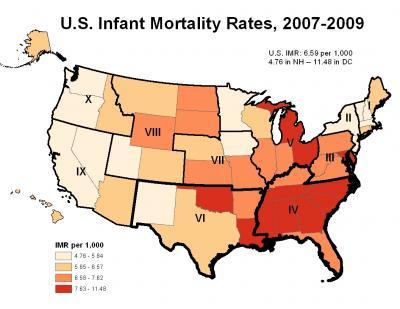Population health has a lot of different factors - and infant mortality is one of them but it doesn't tell the entire story. Some in America laud Cuban health care, for example, but Cuba just had a cholera epidemic, something that doesn't happen in the United States.
And Cubans abort babies if there are signs of trouble, as do many industrialized nations, while America does not. Trying to save more babies is one reason why America ranks 27th among industrialized nations in infant mortality, and if you are in the business of criticizing American health care, you can stop thinking critically right there.
But it doesn't tell the real story. Southern states in the U.S. suffer from higher rates of infant mortality than northern states and scholars from the U.S. Department of Health and Human Services' Maternal and Child Health Bureau analyzed the most recent National Center for Health Statistics Period Linked Birth/Infant Death Data Files, from 2007-2009, to try and gain an understanding of why, controlling for race, underlying cause of death and gestational age.
Overall, the U.S. infant mortality rate (IMR) for 2007-2009 was 6.59 per 1000 live births; 1.18 excess infant deaths per 1000 live births in the South, which represents a total of about 1600 excess infant deaths per year, and 5018 excess infant deaths between 2007 and 2009.
Nothing you can do about premature births, some women are just at risk, and as noted Americans carry more babies with congenital anomalies to term than other countries. But unexplained infants deaths - what used to be called Sudden Infant Death Syndrome (SIDS) and is now Sudden Unexpected Infant Death (SUID), were higher.
"Overall, prematurity, congenital anomalies, and Sudden Unexpected Infant Death (SUID) were the three leading causes of death in the South and the rest of the U.S. However, SUID and preterm-related death were the largest causes of excess infant mortality in the South compared to other regions," says lead investigator Ashley H. Hirai, PhD.

SUID/SIDS and preterm-related death were the largest causes of excess infant mortality in the South compared to other regions. Do southern people love babies more than those in the north do, and try to have more, even with difficulties? Or is it something else? Credit: American Journal of Preventive Medicine
Race was a factor in the high IMRs found in the south, though various groups impacted states differently. Whites had higher mortality rates in Kentucky and Oklahoma while blacks had higher infant mortality in Florida, Georgia, Mississippi, South Carolina, and Louisiana.
The authors say promoting safe sleep practices in hospitals and communities and preventing/ treating chronic conditions before and between pregnancies are some of the steps that can be taken to address infant mortality rates. The researchers highlighted the importance of state data systems to recognize needs and priorities among various risk and protective factors that can be targeted for intervention.




Comments